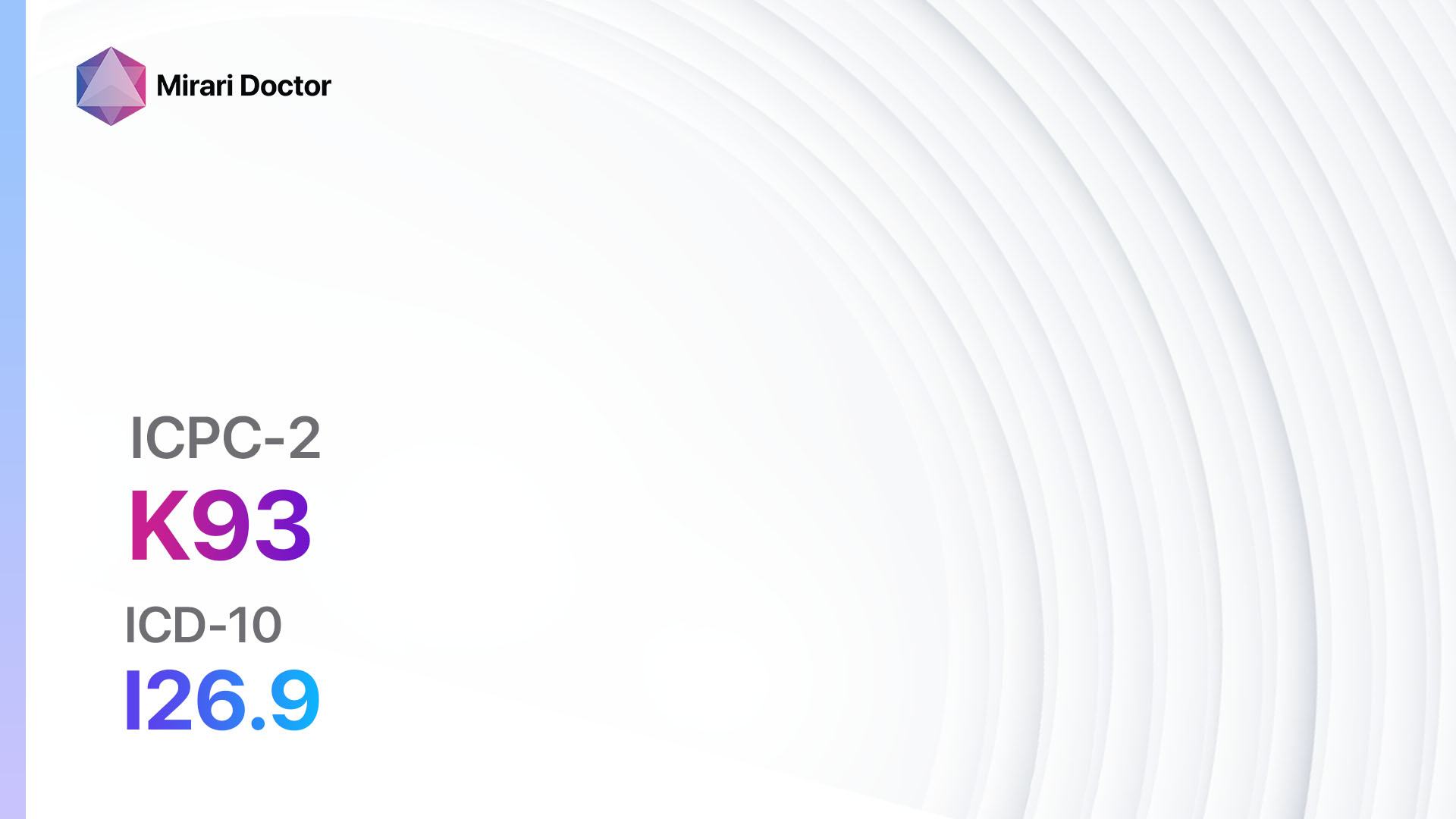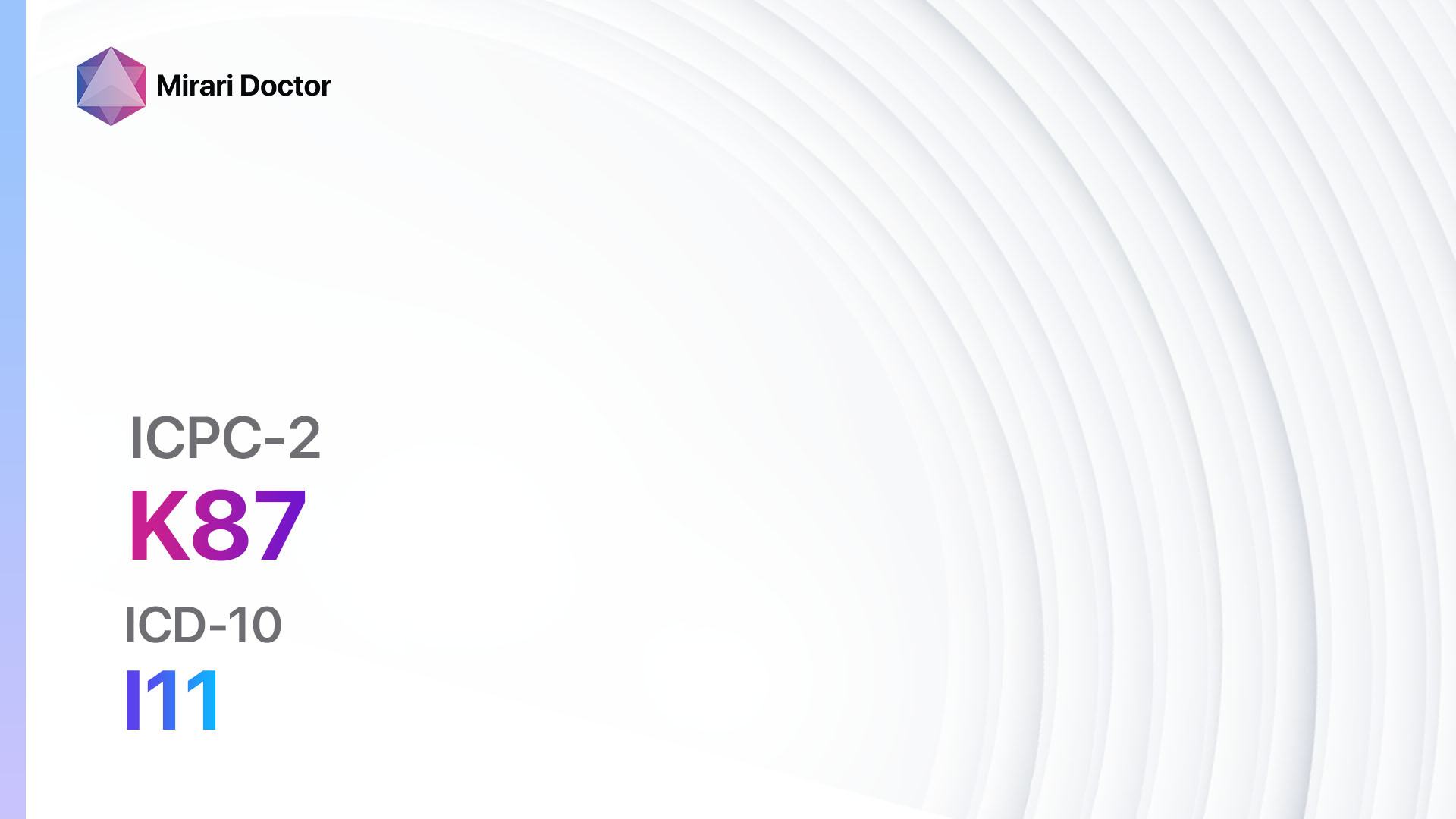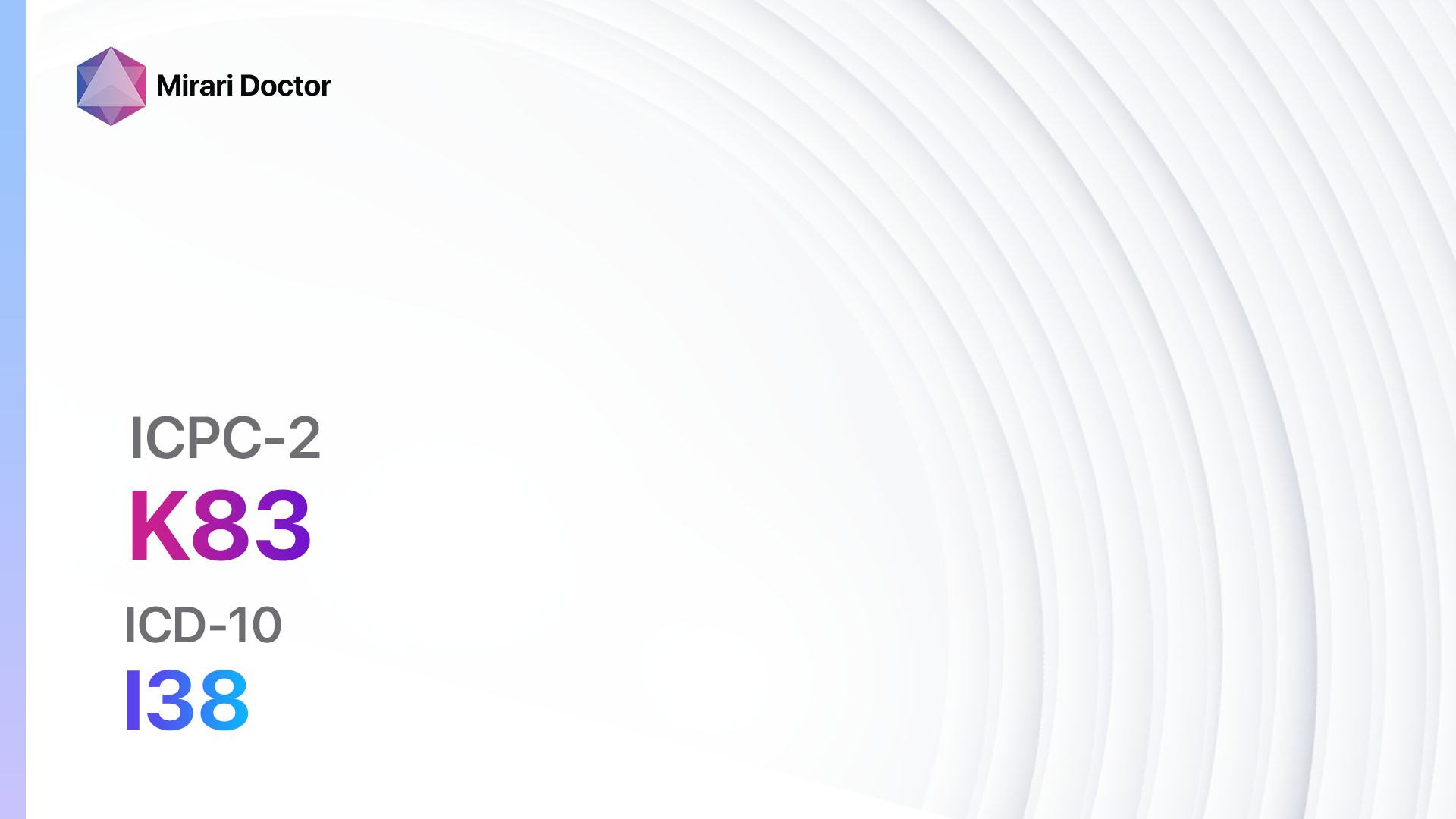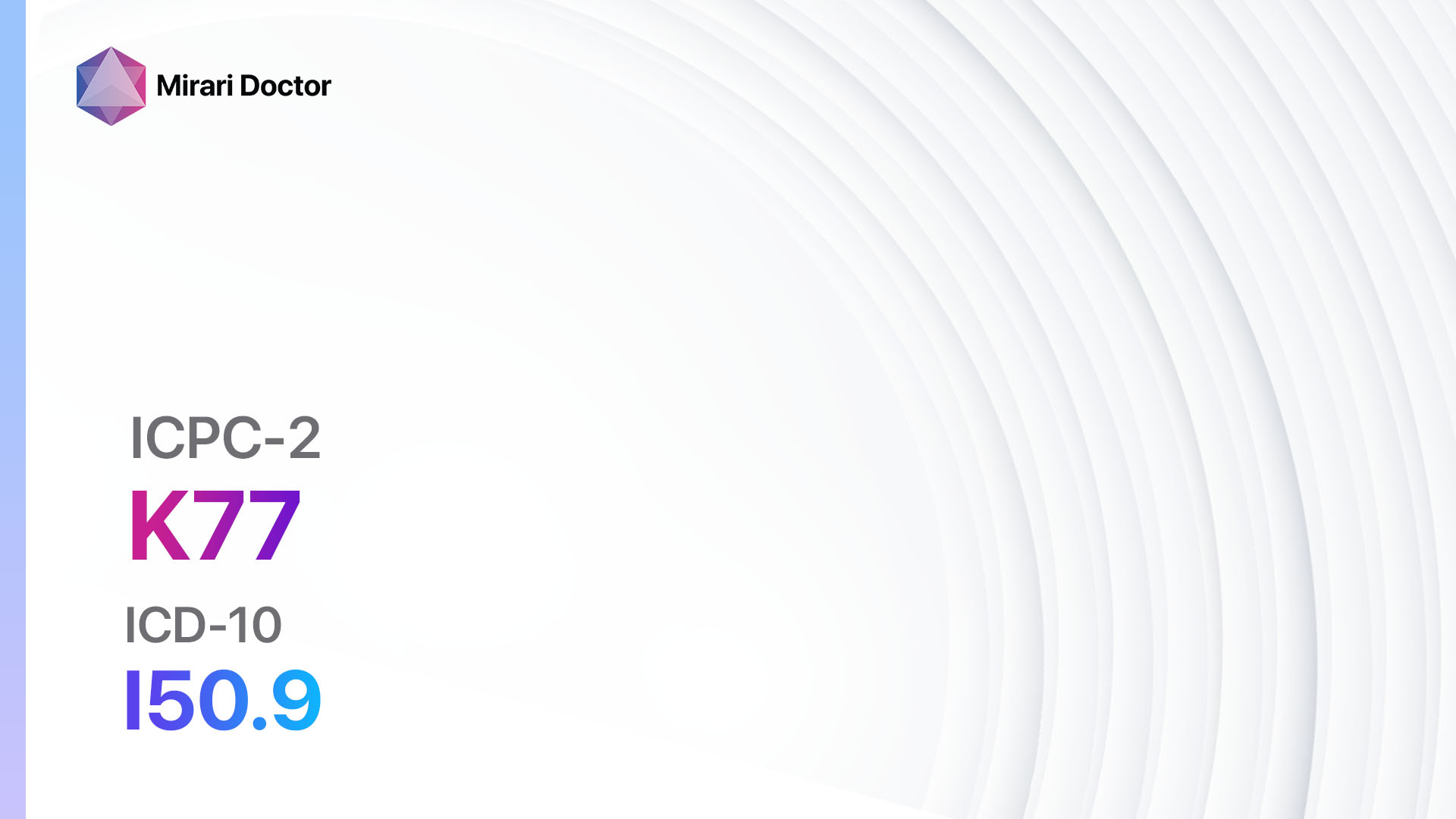
Introduction
Heart disease is a broad term that encompasses various conditions affecting the heart and blood vessels. It is a significant health concern worldwide and a leading cause of morbidity and mortality[1]. The aim of this guide is to provide healthcare professionals with a comprehensive overview of heart disease other than atherosclerosis and coronary artery disease, including its symptoms, causes, diagnostic steps, possible interventions, and patient education.
Codes
Symptoms
- Chest pain or discomfort: This may be experienced as a squeezing, pressure, or tightness in the chest. It can also radiate to the arms, shoulders, neck, jaw, or back[2].
- Shortness of breath: Difficulty breathing or feeling breathless, especially during physical activity or at rest[3].
- Fatigue: Feeling tired or exhausted even with minimal exertion[4].
- Palpitations: Sensation of irregular or rapid heartbeats[5].
- Dizziness or lightheadedness: Feeling faint or woozy[6].
- Swelling in the legs, ankles, or feet: Fluid retention due to heart failure[7].
Causes
- Cardiomyopathy: A disease of the heart muscle that affects its ability to pump blood effectively[8].
- Valvular heart disease: Abnormalities in the heart valves, such as stenosis or regurgitation[9].
- Congenital heart defects: Structural abnormalities present at birth[10].
- Arrhythmias: Abnormal heart rhythms, including atrial fibrillation or ventricular tachycardia.
- Pericardial diseases: Inflammation or infection of the pericardium, the sac surrounding the heart.
- Myocarditis: Inflammation of the heart muscle, often due to viral infections.
- Heart tumors: Rare tumors that can affect the heart.
Diagnostic Steps
Medical History
- Gather information about the patient’s risk factors, such as smoking, high blood pressure, diabetes, obesity, and family history of heart disease.
- Inquire about any previous medical conditions, such as hypertension, diabetes, or kidney disease.
- Ask about the presence and characteristics of symptoms, such as chest pain, shortness of breath, or fatigue.
Physical Examination
- Measure blood pressure, heart rate, and respiratory rate.
- Auscultate the heart for abnormal sounds, such as murmurs or irregular rhythms.
- Examine the extremities for signs of swelling or edema.
- Assess the lungs for crackles or signs of fluid overload.
Laboratory Tests
- Complete blood count (CBC): To evaluate for anemia or infection.
- Lipid profile: To assess cholesterol and triglyceride levels.
- Cardiac biomarkers: Such as troponin and B-type natriuretic peptide (BNP) to evaluate for heart muscle damage or heart failure.
- Thyroid function tests: To rule out thyroid disorders that may contribute to heart disease.
- Liver and kidney function tests: To assess organ function and potential contraindications for certain medications.
Diagnostic Imaging
- Electrocardiogram (ECG): To evaluate the electrical activity of the heart and detect any abnormal rhythms or ischemic changes.
- Echocardiogram: To assess the structure and function of the heart, including the heart valves, chambers, and ejection fraction.
- Stress test: To evaluate the heart’s response to physical activity and detect any exercise-induced abnormalities.
- Cardiac catheterization: Invasive procedure to visualize the coronary arteries and assess blood flow.
Other Tests
- Holter monitor: A portable device that records the heart’s electrical activity over a 24-hour period to detect any arrhythmias.
- Cardiac CT scan or MRI: Imaging modalities that provide detailed images of the heart and blood vessels.
- Endomyocardial biopsy: In rare cases, a small sample of heart tissue may be taken to evaluate for specific heart diseases.
Follow-up and Patient Education
- Schedule regular follow-up appointments to monitor the patient’s condition and adjust treatment as necessary.
- Educate the patient about the importance of lifestyle modifications, such as maintaining a healthy diet, exercising regularly, quitting smoking, and managing stress.
- Provide information about medications, their indications, potential side effects, and the importance of adherence.
- Discuss the signs and symptoms of worsening heart disease and when to seek immediate medical attention.
Possible Interventions
Traditional Interventions
Medications:
Top 5 drugs for Heart disease other:
- Angiotensin-converting enzyme (ACE) inhibitors (e.g., Lisinopril, Enalapril):
- Cost: Generic versions can be $10-$50/month.
- Contraindications: History of angioedema with ACE inhibitors, bilateral renal artery stenosis.
- Side effects: Dry cough, dizziness, hypotension.
- Severe side effects: Angioedema, hyperkalemia, renal impairment.
- Drug interactions: Potassium supplements, nonsteroidal anti-inflammatory drugs (NSAIDs).
- Warning: Monitoring of renal function and potassium levels is required.
- Beta-blockers (e.g., Metoprolol, Carvedilol):
- Cost: Generic versions are typically <$30/month.
- Contraindications: Severe bradycardia, heart block, uncontrolled heart failure.
- Side effects: Fatigue, dizziness, bradycardia.
- Severe side effects: Bronchospasm, heart block, worsening heart failure.
- Drug interactions: Calcium channel blockers, insulin.
- Warning: Should not be abruptly stopped.
- Diuretics (e.g., Furosemide, Hydrochlorothiazide):
- Cost: Generic versions can be <$10/month.
- Contraindications: Severe electrolyte imbalance, anuria.
- Side effects: Frequent urination, electrolyte abnormalities.
- Severe side effects: Severe dehydration, hypotension.
- Drug interactions: Nonsteroidal anti-inflammatory drugs (NSAIDs), lithium.
- Warning: Monitoring of electrolytes and renal function is required.
- Antiplatelet agents (e.g., Aspirin, Clopidogrel):
- Cost: Aspirin is inexpensive (<$10/month). Clopidogrel is $10-$100/month for generic.
- Contraindications: Active bleeding, peptic ulcer disease.
- Side effects: Upset stomach, bleeding.
- Severe side effects: Severe bleeding, allergic reactions.
- Drug interactions: Nonsteroidal anti-inflammatory drugs (NSAIDs), other blood thinners.
- Warning: Risk of bleeding.
- Anticoagulants (e.g., Warfarin, Apixaban):
- Cost: Generic warfarin is inexpensive (<$10/month). Apixaban is $300-$400/month.
- Contraindications: Active bleeding, history of intracranial hemorrhage.
- Side effects: Increased risk of bleeding.
- Severe side effects: Severe bleeding, allergic reactions.
- Drug interactions: Many drug interactions, including other anticoagulants and certain antibiotics.
- Warning: Regular monitoring of international normalized ratio (INR) is required for warfarin.
Surgical Procedures:
- Pacemaker implantation: For patients with arrhythmias or conduction abnormalities.
- Valve repair or replacement: Surgical intervention to repair or replace damaged heart valves.
- Cardiac resynchronization therapy (CRT): Implantation of a device to improve heart function in patients with heart failure and dyssynchrony.
- Heart transplant: Reserved for end-stage heart disease when other interventions have failed.
Alternative Interventions
- Acupuncture: May help improve blood flow and reduce pain. Cost: $60-$120 per session.
- Chelation therapy: Controversial treatment involving the administration of chelating agents to remove heavy metals from the body. Cost: $75-$150 per session.
- Hyperbaric oxygen therapy: Involves breathing pure oxygen in a pressurized chamber to increase oxygen delivery to tissues. Cost: $200-$300 per session.
- Herbal supplements: Some herbs, such as garlic and hawthorn, may have potential benefits for heart health. Cost: Varies depending on the specific supplement.
- Mind-body techniques: Practices such as meditation, yoga, and tai chi may help reduce stress and improve overall well-being. Cost: Varies depending on the specific practice.
Lifestyle Interventions
- Dietary modifications: Encourage a heart-healthy diet rich in fruits, vegetables, whole grains, lean proteins, and low-fat dairy products. Cost: Varies depending on food choices.
- Regular exercise: Recommend at least 150 minutes of moderate-intensity aerobic activity or 75 minutes of vigorous-intensity aerobic activity per week. Cost: Varies depending on the chosen activity.
- Smoking cessation: Provide resources and support to help patients quit smoking. Cost: Varies depending on the chosen method (e.g., nicotine replacement therapy, counseling).
- Stress management: Teach stress reduction techniques, such as deep breathing exercises, mindfulness, or relaxation techniques. Cost: Varies depending on the chosen method (e.g., self-guided, therapist-led).
- Weight management: Encourage weight loss for overweight or obese patients through a combination of diet and exercise. Cost: Varies depending on the chosen weight loss program or professional guidance.
It is important to note that the cost ranges provided are approximate and may vary depending on the location and availability of the interventions. Healthcare professionals should consider individual patient factors, preferences, and resources when determining the most appropriate interventions for heart disease other than atherosclerosis and coronary artery disease.
Mirari Cold Plasma Alternative Intervention
Understanding Mirari Cold Plasma
- Safe and Non-Invasive Treatment: Mirari Cold Plasma is a safe and non-invasive treatment option for various skin conditions. It does not require incisions, minimizing the risk of scarring, bleeding, or tissue damage.
- Efficient Extraction of Foreign Bodies: Mirari Cold Plasma facilitates the removal of foreign bodies from the skin by degrading and dissociating organic matter, allowing easier access and extraction.
- Pain Reduction and Comfort: Mirari Cold Plasma has a local analgesic effect, providing pain relief during the treatment, making it more comfortable for the patient.
- Reduced Risk of Infection: Mirari Cold Plasma has antimicrobial properties, effectively killing bacteria and reducing the risk of infection.
- Accelerated Healing and Minimal Scarring: Mirari Cold Plasma stimulates wound healing and tissue regeneration, reducing healing time and minimizing the formation of scars.
Mirari Cold Plasma Prescription
Video instructions for using Mirari Cold Plasma Device – K84 Heart disease other (ICD-10:I51.9)
| Mild | Moderate | Severe |
| Mode setting: 1 (Infection) Location: 5 (Lungs) Morning: 15 minutes, Evening: 15 minutes |
Mode setting: 1 (Infection) Location: 5 (Lungs) Morning: 30 minutes, Lunch: 30 minutes, Evening: 30 minutes |
Mode setting: 1 (Infection) Location: 5 (Lungs) Morning: 30 minutes, Lunch: 30 minutes, Evening: 30 minutes |
| Mode setting: 2 (Wound Healing) Location: 5 (Lungs) Morning: 15 minutes, Evening: 15 minutes |
Mode setting: 2 (Wound Healing) Location: 5 (Lungs) Morning: 30 minutes, Lunch: 30 minutes, Evening: 30 minutes |
Mode setting: 2 (Wound Healing) Location: 5 (Lungs) Morning: 30 minutes, Lunch: 30 minutes, Evening: 30 minutes |
| Mode setting: 7 (Immunotherapy) Location: 1 (Sacrum) Morning: 15 minutes, Evening: 15 minutes |
Mode setting: 7 (Immunotherapy) Location: 1 (Sacrum) Morning: 30 minutes, Lunch: 30 minutes, Evening: 30 minutes |
Mode setting: 7 (Immunotherapy) Location: 1 (Sacrum) Morning: 30 minutes, Lunch: 30 minutes, Evening: 30 minutes |
| Mode setting: 7 (Immunotherapy) Location: 4 (Heart, Bile & Pancreas) Morning: 15 minutes, Evening: 15 minutes |
Mode setting: 7 (Immunotherapy) Location: 4 (Heart, Bile & Pancreas) Morning: 30 minutes, Lunch: 30 minutes, Evening: 30 minutes |
Mode setting:7 (Immunotherapy) Location: 4 (Heart, Bile & Pancreas) Morning: 30 minutes, Lunch: 30 minutes, Evening: 30 minutes |
| Total Morning: 60 minutes approx. $10 USD, Evening: 60 minutes approx. $10 USD |
Total Morning: 120 minutes approx. $20 USD, Lunch: 120 minutes approx. $20 USD, Evening: 120 minutes approx. $20 USD, |
Total Morning: 120 minutes approx. $20 USD, Lunch: 120 minutes approx. $20 USD, Evening: 120 minutes approx. $20 USD, |
| Usual treatment for 7-60 days approx. $140 USD – $1200 USD | Usual treatment for 6-8 weeks approx. $2,520 USD – $3,360 USD |
Usual treatment for 3-6 months approx. $5,400 USD – $10,800 USD
|
 |
|
Use the Mirari Cold Plasma device to treat Heart disease other effectively.
WARNING: MIRARI COLD PLASMA IS DESIGNED FOR THE HUMAN BODY WITHOUT ANY ARTIFICIAL OR THIRD PARTY PRODUCTS. USE OF OTHER PRODUCTS IN COMBINATION WITH MIRARI COLD PLASMA MAY CAUSE UNPREDICTABLE EFFECTS, HARM OR INJURY. PLEASE CONSULT A MEDICAL PROFESSIONAL BEFORE COMBINING ANY OTHER PRODUCTS WITH USE OF MIRARI.
Step 1: Cleanse the Skin
- Start by cleaning the affected area of the skin with a gentle cleanser or mild soap and water. Gently pat the area dry with a clean towel.
Step 2: Prepare the Mirari Cold Plasma device
- Ensure that the Mirari Cold Plasma device is fully charged or has fresh batteries as per the manufacturer’s instructions. Make sure the device is clean and in good working condition.
- Switch on the Mirari device using the power button or by following the specific instructions provided with the device.
- Some Mirari devices may have adjustable settings for intensity or treatment duration. Follow the manufacturer’s instructions to select the appropriate settings based on your needs and the recommended guidelines.
Step 3: Apply the Device
- Place the Mirari device in direct contact with the affected area of the skin. Gently glide or hold the device over the skin surface, ensuring even coverage of the area experiencing.
- Slowly move the Mirari device in a circular motion or follow a specific pattern as indicated in the user manual. This helps ensure thorough treatment coverage.
Step 4: Monitor and Assess:
- Keep track of your progress and evaluate the effectiveness of the Mirari device in managing your Heart disease other. If you have any concerns or notice any adverse reactions, consult with your health care professional.
Note
This guide is for informational purposes only and should not replace the advice of a medical professional. Always consult with your healthcare provider or a qualified medical professional for personal advice, diagnosis, or treatment. Do not solely rely on the information presented here for decisions about your health. Use of this information is at your own risk. The authors of this guide, nor any associated entities or platforms, are not responsible for any potential adverse effects or outcomes based on the content.
Mirari Cold Plasma System Disclaimer
- Purpose: The Mirari Cold Plasma System is a Class 2 medical device designed for use by trained healthcare professionals. It is registered for use in Thailand and Vietnam. It is not intended for use outside of these locations.
- Informational Use: The content and information provided with the device are for educational and informational purposes only. They are not a substitute for professional medical advice or care.
- Variable Outcomes: While the device is approved for specific uses, individual outcomes can differ. We do not assert or guarantee specific medical outcomes.
- Consultation: Prior to utilizing the device or making decisions based on its content, it is essential to consult with a Certified Mirari Tele-Therapist and your medical healthcare provider regarding specific protocols.
- Liability: By using this device, users are acknowledging and accepting all potential risks. Neither the manufacturer nor the distributor will be held accountable for any adverse reactions, injuries, or damages stemming from its use.
- Geographical Availability: This device has received approval for designated purposes by the Thai and Vietnam FDA. As of now, outside of Thailand and Vietnam, the Mirari Cold Plasma System is not available for purchase or use.
References
- Roth GA, Mensah GA, Johnson CO, et al. Global Burden of Cardiovascular Diseases and Risk Factors, 1990-2019: Update From the GBD 2019 Study. J Am Coll Cardiol. 2020;76(25):2982-3021. doi:10.1016/j.jacc.2020.11.010
- Fihn SD, Gardin JM, Abrams J, et al. 2012 ACCF/AHA/ACP/AATS/PCNA/SCAI/STS guideline for the diagnosis and management of patients with stable ischemic heart disease: a report of the American College of Cardiology Foundation/American Heart Association task force on practice guidelines, and the American College of Physicians, American Association for Thoracic Surgery, Preventive Cardiovascular Nurses Association, Society for Cardiovascular Angiography and Interventions, and Society of Thoracic Surgeons. Circulation. 2012;126(25):e354-e471. doi:10.1161/CIR.0b013e318277d6a0
- Ponikowski P, Voors AA, Anker SD, et al. 2016 ESC Guidelines for the diagnosis and treatment of acute and chronic heart failure: The Task Force for the diagnosis and treatment of acute and chronic heart failure of the European Society of Cardiology (ESC)Developed with the special contribution of the Heart Failure Association (HFA) of the ESC. Eur Heart J. 2016;37(27):2129-2200. doi:10.1093/eurheartj/ehw128
- Ponikowski P, Voors AA, Anker SD, et al. 2016 ESC Guidelines for the diagnosis and treatment of acute and chronic heart failure: The Task Force for the diagnosis and treatment of acute and chronic heart failure of the European Society of Cardiology (ESC)Developed with the special contribution of the Heart Failure Association (HFA) of the ESC. Eur Heart J. 2016;37(27):2129-2200. doi:10.1093/eurheartj/ehw128
- Zimetbaum P, Josephson ME. Evaluation of patients with palpitations. N Engl J Med. 1998;338(19):1369-1373. doi:10.1056/NEJM199805073381907
- Ponikowski P, Voors AA, Anker SD, et al. 2016 ESC Guidelines for the diagnosis and treatment of acute and chronic heart failure: The Task Force for the diagnosis and treatment of acute and chronic heart failure of the European Society of
- Weis, Sara M (2008.0). Vascular permeability in cardiovascular disease and cancer. DOI: 10.1097/MOH.0b013e3282f97d86
- Meneton, Pierre ; Jeunemaitre, Xavier ; de Wardener, Hugh E ; Macgregor, Graham A (2005.0). Links Between Dietary Salt Intake, Renal Salt Handling, Blood Pressure, and Cardiovascular Diseases. DOI: 10.1152/physrev.00056.2003
- American Diabetes Association (2016.0). Cardiovascular Disease and Risk Management. DOI: 10.2337/dc16-S011
- Parks, Tom ; Smeesters, Pierre R ; Steer, Andrew C (2012.0). Streptococcal skin infection and rheumatic heart disease. DOI: 10.1097/QCO.0b013e3283511d27
Related articles
Made in USA



























